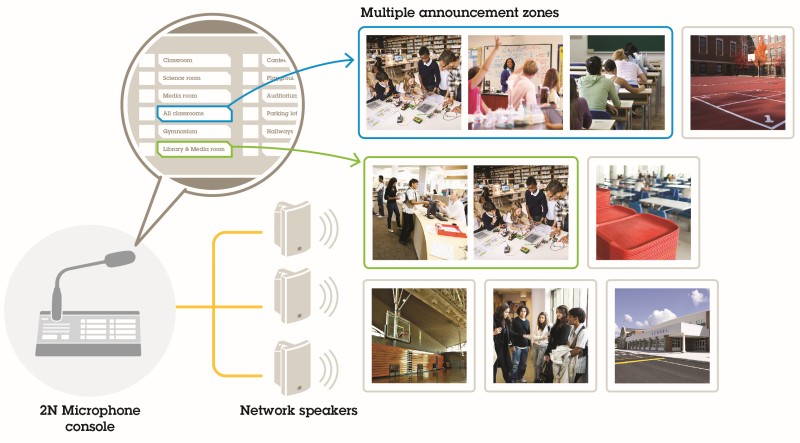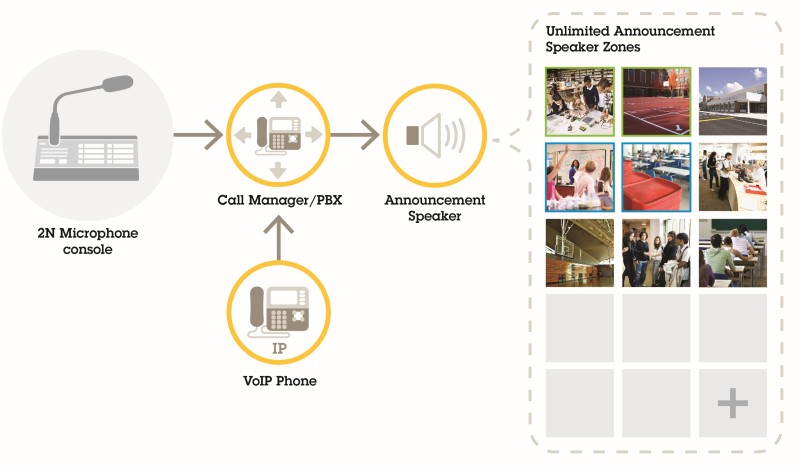Introduction
The 2N SIP Mic is a two-way network microphone console with a built-in audio management server. It can be easily integrated with Axis network speakers to form a complete public-address system, possible to purchase from a single distributor. Based on open standards, 2N SIP Mic can also be connected to other IT systems.
This manual describes suggested use cases for 2N SIP Mic with Axis network speaker system, and provides step-by-step guides for how to configure the hardware. Note that only use cases that support Axis equipment are described, and for details about other possibilities using 2N SIP Mic, an extended user manual can be found on the 2N website.
Hardware
- Default login credentials for 2N SIP Mic:
User name:
AdminPassword:
2n
2N SIP Mic comes with DHCP enabled as default setting. To use the default IP address, 192.168.1.100, press the call button 15 times after restart. For discovery, you can use Axis IP Utility, ADM or the 2N® Helios IP network scanner found at www.2n.cz/products/2n-network-scanner.
If you want to connect the 2N SIP Mic to an Axis product, you need to update your product with the latest firmware. You can download firmware from the 2N website.
Trigger audio from 2N SIP Mic
Use transmit.cgi and send HTTP request
2N SIP Mic has support for HTTP trigger with password authentication and can send general VAPIX commands to all Axis products. However, it cannot receive any VAPIX commands.
When using 2N SIP Mic in combination with Axis network audio systems, it is possible to address zones for public announcements by using transmit.cgi. A maximum of 12 IP addresses can be assigned per zone/button at the same time. Zones can easily be changed, removed, or added in an instant, over the network.

Use SIP calls and DTMF triggers
2N SIP Mic has support for SIP and DTMF (dual-tone multiple-frequency) signals. SIP calls can be initiated by 2N SIP Mic either via a VoIP PBX, or, if the addressed device is in the same network, as a SIP peer-to-peer connection. To address many speaker zones, the buttons of 2N SIP Mic may be insufficient. It is then possible to instead use paging groups defined in the SIP PBX, in order to address the zones.

Suggested use cases
In use cases A, B, and C, audio is triggered by using transmit.cgi or sending a http request. In use cases D, E, and F, audio is triggered using SIP calls and DTMF.
A – Use transmit.cgi for public announcements to one speaker group
A basic installation for this use case could contain 2N SIP Mic in combination with an Axis network speaker group consisting of products such as AXIS C3003-E, AXIS C1004-E, AXIS C2005 or AXIS C8033.
An operator would address this whole group for a general announcement.
Configure a zone with a VAPIX destination.
Assign the zone to a 2N SIP Mic button.
B – Use transmit.cgi for public announcements to several speaker groups
An installation for this use case could contain 2N SIP Mic in combination with an Axis network speaker group consisting of C1004-E and/or AXIS C2005-E for background music. Two other speaker groups, consisting of multiple AXIS C3003-E speakers, could be installed in a parking area and in a playground.
An operator could address the first speaker group (playing background music) for a general announcement, but later on, also the other speaker groups for another announcement to all three zones.
Configure a zone with multiple VAPIX destinations, to address several IP addresses in parallel.
Assign the zone to a 2N SIP Mic button.
C – Use HTTP request to trigger audio clip stored on leader speaker of a group
A basic installation for this use case could contain 2N SIP Mic in combination with an Axis network speaker group consisting of products such as AXIS C3003-E, AXIS C1004-E, AXIS C2005, or AXIS C8033.
An operator would trigger an audio clip stored on a speaker, by pressing a button on 2N SIP Mic. Clip example: http://ip address of the speaker/axis-cgi/playclip.cgi?location=ding_dong.mp3&repeat=-1&volume=100
Prepare an audio clip on the leader speaker of the speaker group.
Configure a 2N SIP Mic button to trigger the audio clip on the speaker.
- Note
You need to add the username and password at the beginning of the speaker link:
http://root:pass@
D – Use SIP for public announcements to one speaker
A basic installation for this use case could contain 2N SIP Mic in combination with an Axis network speaker group consisting of products such as AXIS C3003-E, AXIS C1004-E, AXIS C2005, or AXIS C8033.
An operator would address an Axis SIP-capable device, in this case AXIS C1004-E, for a general announcement, by initiating a peer-to-peer call from 2N SIP Mic.
Enable SIP on the speaker so that it can receive SIP calls.
Configure and enable the right VoIP settings for peer-to-peer calls on 2N SIP Mic.
Configure 2N SIP Mic to initiate a peer-to-peer call.
- Note
The SIP destination address must be a valid SIP URL that includes a host part before the @ and the network IP address after the @. In this example the host part can be anything between 0 and 9.
Assign the zone to a 2N SIP Mic button.
When you press the configured button, 2N SIP Mic will initiate a peer-to-peer SIP call to the defined SIP destination (the speaker).
E – Use SIP for public announcements to a speaker group
A basic installation for this use case could contain 2N SIP Mic in combination with an Axis network speaker group consisting of products such as AXIS C3003-E, AXIS C1004-E, AXIS C2005, or AXIS C8033.
An operator would address the whole speaker group for a general announcement, by initiating a SIP call from 2N SIP Mic.
Enable SIP on the leader speaker so that it can receive SIP calls.
Configure and enable the right VoIP settings to register 2N SIP Mic to a VoIP PBX.
- Note
Before you start your configuration, make sure that you have the needed information and resources to see the configuration through. You can use the device provisioning form to collect the configuration parameters. Axis provides no support for PBX configuration, but some configuration examples are available if needed.
Device provisioning form Brand/type of SIP registrar / PBX SIP user ID SIP authentication user SIP password SIP port number (if not 5060) SIP register address (FQDN) SIP proxy server address (FQDN) SIP via UDP or TCP DTMF RFC2833 DTMF SIP info Video H.264 support enabled in PBX Sufficient PBX licenses available Supported voice codec RTP port range Contact details for SIP service provider customer support Contact details for PBX support Configure 2N SIP Mic to initiate a VoIP call to a zone, via a PBX.
Assign the preconfigured zone to a 2N SIP Mic button.
When you press the button, 2N SIP Mic will initiate a call to the destination number (the zone/leader speaker).
F – Use DTMF for public announcement to a speaker group
A basic installation for this use case could contain 2N SIP Mic in combination with an Axis network speaker group consisting of products such as AXIS C3003-E, AXIS C1004-E, AXIS C2005, or AXIS C8033.
An operator would address a speaker group for playing a pre-recorded message triggered by a DTMF tone.
Enable DTMF on 2N SIP Mic.
Configure a 2N SIP Mic button to send DTMF.
Configure the leader speaker to receive DTMF tones.
Configure the speaker to trigger the action Play audio clip when receiving a DTMF tone.